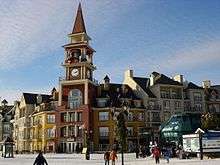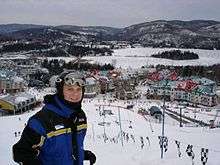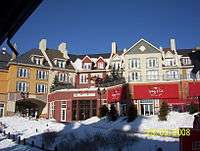Mont Tremblant Resort
| Mont-Tremblant Ski Resort | |
|---|---|
 | |
 Mont-Tremblant resort and pedestrian village | |
 Tremblant Location of Mont-Tremblant in Quebec | |
| Location |
Mont-Tremblant, Quebec, |
| Nearest city | Montreal: 130 km (80 mi) |
| Coordinates | 46°12′50″N 74°35′06″W / 46.214°N 74.585°WCoordinates: 46°12′50″N 74°35′06″W / 46.214°N 74.585°W |
| Vertical | 645 m (2,116 ft) |
| Top elevation | 875 m (2,871 ft) |
| Base elevation | 230 m (755 ft) |
| Skiable area | 2.53 km2 (630 acres) |
| Runs |
95 Total |
| Longest run | 6 km (4 mi) (Nansen) |
| Lift system |
14 total 2 gondolas, 9 chairlifts, 3 magic carpets |
| Lift capacity | 27,230 skiers/hr |
| Snowfall | 395 cm (156 in) per year |
| Snowmaking | 71% |
| Website | Tremblant.ca |
Mont Tremblant Ski Resort (known as Tremblant) is a year-round resort in the Laurentian Mountains of Quebec, Canada, about 130 km (80 mi) northwest of Montreal. It is best known as a ski destination, but also features Lake Tremblant suitable for swimming and two golf courses in the summer months. The name of the mountain, Mont Tremblant, was derived from the local Algonquin natives, who called it the "trembling mountain."[1] The summit is at an elevation of 875 metres (2,871 ft), which makes it one of the tallest peaks in the Laurentians.
The mountain and resort are part of the Mont-Tremblant National Park and are both located near the village of Mont-Tremblant.
History
Development
Joseph Bondurant Ryan, an explorer from a wealthy American family from Philadelphia, came to the region prospecting gold in 1938. Accompanied by Harry Wheeler (founder of the Gray Rocks Inn in Mont Tremblant) and Lowell Thomas, the American journalist, they climbed to the summit of Mont Tremblant with skis wrapped in seal skins for traction. After an exhausting trek to the summit, it's said that Joseph Ryan vowed to transform the landscape into a world-class alpine village. Only one year later, his dream was realized. On February 12, 1939, Joeseph Ryan opened the Mont Tremblant Lodge, which remains part of the pedestrian village today.
In its early years, Lowell Thomas, the American radio broadcaster, was an avid skier who helped popularize the resort by broadcasting shows from the site, thereby establishing the resort as a prime destination for skiers. The resort named a triple ski lift, which is located on the north mountainside, and trails after him as well as other early devotees.
Following the sudden death of Joseph Bondurant Ryan in 1950, the Mont Tremblant ski resort was operated by his wife Mary Rutherfoord Johnson Ryan until 1965, when it was sold to local Quebec entrepreneurs. The resort operated independently until 1991, when it was purchased by Intrawest, which immediately expanded the pedestrian resort village with architecture reminiscent of traditional Quebec and built new ski lifts, including a gondola. Other changes included building the Grand Manitou summit lodge.
In 2009 a casino located at the base of the soleil trails was opened. The casino is serviced by a new 8 passenger gondola that runs from the main resort to the casino.
Joseph Bondurant Ryan is buried next to the St. Bernard Chappel which he built in 1940-41 at the base of the alpine village, along with his wife Mary and son Peter, who died in Paris, France in 1962 at the age of 22 as a result of an auto racing accident. Peter Ryan was an accomplished champion skier who'd been named to the Canadian Olympic ski team, but had switched to auto racing after a 1959 sking accident. He showed tremendous immediate talent in auto racing and was the first Canadian in Formula One auto racing and the winner of the first Canadian Grand Prix held at Mosport in 1961.
On March 16, 2009, actress Natasha Richardson sustained a head injury when she fell while taking a beginner skiing lesson at the resort. She died two days later in New York City.
Resort facilities

As of 2005, Mont Tremblant had been recognized by Ski Canada Magazine as the #1 ski resort in Eastern North America for 14 consecutive years. The main resort has more than 600 acres (2.4 km2) of ski and snowboarding trails in four distinct areas: North Side (Versant Nord), South Side (Versant Sud), Sunny Side (Versant Soleil) and The Edge (Versant Edge).
As of the 2005 winter season, the resort had 94 marked downhill trails, the longest 6 km (3.7 mi), 16 designated easy, 31 intermediate, 37 difficult and 10 expert.
The resort features 12 ski lifts, consisting of 1 gondola, 5 detachable chairlifts, 3 regular chairlifts and 3 magic carpets. Total lift capacity is 27,230 skiers per hour.
The top of the mountain has a chalet and restaurant, Le Grand Manitou, open winter and summer.
Pedestrian Village

There is an open gondola-style lift called The Cabriolet which connects the upper and lower parts of the pedestrian village. From the top of this lift, the main gondola is available to take skiers to the summit of the mountain. There is also a ski trail running through the village for skiers to access the lower level of the village and transportation.
The Mont Tremblant Resort also has extensive shopping for ski and snowboard enthusiasts.[2] The municipal village of Mont-Tremblant is 5 km distant.
Activities
Mont Tremblant has year-round activities which take advantage of the surrounding environment (mountains, forest, lakes and rivers); most are set up on daily schedules and usually take the form of tours in small groups and are accessible to families; most are run by independent operators or specialized guides.
Summer activities include airplane tours, all-terrain vehicle tours, croisieres, boating, caleche rides, canoeing trips, cycling, dune buggy tours, fishing tours, golf, helicopter tours, hiking, horse back riding, lake cruises, mountain biking, paintball games, rafting, rock climbing school, spas, via-ferratta, waterskiing and wakeboarding, white-water rafting, and zip-lines.

Winter activities include cross-country skiing, dogsledding, downhill skiing and ski schools, helicopter tours, horseback riding, ice-climbing, ice fishing, ice skating, paintball, sleigh rides, snowmobiling, snowshoeing, tubing and spas.
Lodging
Mont Tremblant has a wide variety of hotel and condo accommodations, many of which are situated in the pedestrian village at the foot of the mountain.
There are additional condo and chalet accommodations located adjacent to the pedestrian village which are managed by the resort's rental agency or other private rental agencies. These accommodations feature shuttle bus service which provides guests some of the same convenience afforded to people staying in the pedestrian village.
Most condo accommodations at the resort area are privately owned. The resort or rental agencies act as a rental broker for these properties by handling maintenance, reservations and other guest-related tasks on behalf of owners.
There are also many privately owned chalets of all levels (from budget to luxury) in the immediate area.
Surrounding area


The surrounding hills and valleys are filled with trails for cross-country skiing and hiking. The ski trails connect with other ski trails in neighboring towns, making it possible for nature lovers to undertake ski excursions lasting several days going (or coming from) as far south as Blainville, Quebec on the outskirts of Montreal. The network of cross-country ski trails consists of over 100 km of terrain, much of which follows the Diable river and its adjacent coniferous forest.
The surrounding valleys of the Mont-Tremblant National Park have small lakes, dense boreal forests and thousands of vacation cottages. There are also world-class golf courses, hiking trails and small rivers suitable for canoeing and swimming.
There are many trails for mountain bikes and a special "route verte" rail trail paved for road bicycle use. The cycling/multifunctional path was built on an abandoned right-of-way of the Montreal-Mont Laurier railway; so cyclists do not have to share a path with motorized vehicles.
See also
References
- ↑ Rubinstein, Dan (October 21, 2011). "The other side of the mountain". Canadian Geographic Travel. Canadian Geographic.
- ↑ Mont Tremblant. "Clothing and Sporting Goods". Mont Tremblant Resort. Retrieved 04/02/2012. Check date values in:
|access-date=(help)
External links
![]() Media related to Mont Tremblant Resort at Wikimedia Commons
Media related to Mont Tremblant Resort at Wikimedia Commons